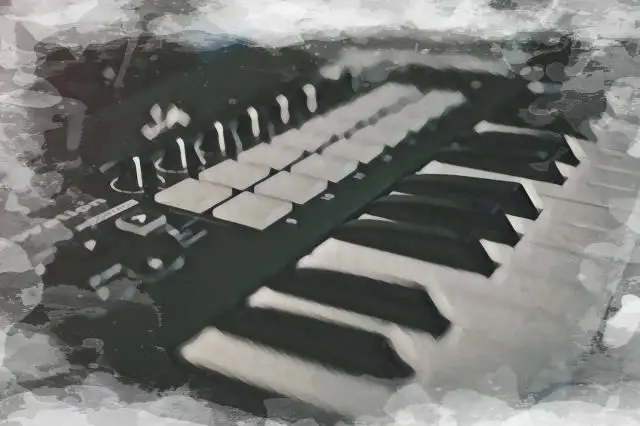Nothing will boost your creativity more than getting out of the studio, and making music in a new environment. In order to do this you'll need a MIDI keyboard that's portable and, ideally, versatile.
And that's where this article comes in.
We're going to look at a bunch of the best mini MIDI controllers, and help you decide which one is right for you.
But first...
What Exactly Is Portable, Anyhoo?
Keyboard controllers come in all shapes and sizes, with a broad spectrum of features and gubbins. This, naturally, makes some MIDI keyboards more portable than others.
Generally speaking, the number of keys will dictate how easy it is to move the board around, but even some 25-note controllers come with a hefty weight.
For the purposes of this article, we've narrowed the list of controllers down to those that are considered mini MIDI keyboards. So they all:
- Have between 25-37 keys
- Operate solely on USB power (or battery power for wireless keyboard models)
- Weigh-in at under 6lbs
Things To Consider
Depending on what kind of (traveling) musician you are, there are a few things you'll want to consider when choosing a portable MIDI controller.
Price
I know, I know. I'm always harking on about budget, and not spending more than you can afford when buying gear. But in the case of a portable midi keyboard, another moolah factor to consider is the likelihood of loss or damage on the road.
If you're the kind of traveler who 'misplaces' their belongings often, you might want to opt for a less expensive MIDI keyboard that would be less painful on your wallet if you have to replace it.
Size, Action, and Number Of Keys
Let's face it, with a portable MIDI keyboard you're never going to replicate the feel of a real piano. All the same, it's worth considering the key size and the number of keys when choosing your traveling companion.
All the boards in this article have between 25 to 37 keys. Any more and they wouldn't fit in your average backpack (and even 37 keys would be a tight fit). But having a 37-note MIDI keyboard to work on could mean a lot less octave button-pushing if you tend to travel a lot up and down the keyboard (pun absolutely intended).
Some mini MIDI controllers have mini keys, others have 3/4 size keys, and some offer full-size keys. Depending on the kind of player you are, and what you're doing with the controller, you may prefer to opt for the larger keys or spend forever editing bum notes out of your piano roll.
Similarly, the action of the keys could be an important deciding factor for you. Do you need velocity sensitivity? Do you crave a semi-weighted feel?
Will you be using the board to augment your live set-up and performances? If so you'll almost certainly want a model with full-size keys, and some response to your passionate velocity changes.
Controls
Most mini keyboards come with at least a handful of controls. These can include:
- Buttons
- Rotary knobs
- Transport controls
- Pitch and mod wheels, or some version of them
- Connectivity for external controls, like a sustain pedal input
If you're just planning on sketching out some ideas in Garageband while you're sunning yourself at the beach (don't forget the lotion) you could get away with a bare minimum of controls. A way of controlling pitch bend and modulation, some way of sustaining notes (whether it's a pedal input or a sustain button), and maybe one assignable controller so you can program in filter sweeps or the like.
But if you're wanting to knock out the next summer anthem while you're chomping a croissant at a street cafe in Paris, you'll want a MIDI keyboard controller that has a comprehensive set of features.
Keep in mind that the more bells and whistles your keyboard controller has, the more cumbersome it will be to lug around.
Drum Pads
Pads are great for programming beats and are just plain fun to use. But not all pads are created equal, and if you spend a good deal of time finger drumming you may want to opt for a higher-end mini keyboard that has more responsive pads than a less expensive model.
Pads can also (sometimes) be assigned to other controls, like triggering samples, launching clips, navigating between scene markers, or sending MIDI CC messages. If you get super granular with your programming you might like to have a bunch of pads at your disposal.
But obviously the more pads you have, the larger your board will be.
As a traveling musician, I'd recommend having some pads, but if they aren't your thing, I've included some models below that don't have any.
Durability
While it's unlikely that you'll be throwing MIDI keyboards down exotic stairways while you're traveling, durability is nonetheless still a consideration.
If you're just going downtown to work in a coffee shop it's likely that any board will survive the trip in your backpack.
But if you're planning on a more nomadic existence there'll be some rigors the road throws at you that will require a sturdy build of the keyboard controller.
No matter how sturdy the board is though, knobs, buttons, and keys can all get snagged on things and break. If possible try to find some kind of protective hard case for your mini midi keyboard.
The 10 Best Mini MIDI Controllers For Traveling
1. Nektar SE25 Mini MIDI Controller Keyboard

- 25 velocity-sensitive mini keys
- 6 Buttons (somewhat assignable)
- DAW integration
- iOS Compatible
- Dimensions: 15.75" x 5.71" x 2.76"
- Weight: 1lb
We're kicking off with possibly the most affordable and perhaps the best mini MIDI keyboard controller on the market, and one of the tiniest. The SE25 is an ultra-compact MIDI keyboard, with some nifty functions hidden beneath the surface.
The two octaves of mini keys sit on a newly-designed velocity-sensitive keybed. There are three different velocity curves, so you can set the board to be responsive to your playing style as you enter MIDI notes on the SE25.
There are no wheels on this little fella; pitch, modulation, and sustain are all controlled by buttons to the left of the keybed. The modulation control is shared by the sustain button and unfortunately is either all on or all off.
Of the six buttons (octave up/down, PB1/PB2, Sustain, Part 2), three can be assigned to various control functions (including MIDI channel control). Pressing the Octave Down and PB1 buttons simultaneously activates transport control mode, and Nektar's DAW integration includes most of the major players on the music software scene. If your DAW of choice isn't supported by this the transport buttons will still work, you'll just have less access to some features.
Note that to take advantage of this DAW integration you'll need to register your product and download the file for your DAW from the Nektar website.
In truly portable style, the SE25 is also compatible with Apple iOS devices. You will need to purchase a separate camera connection kit and be aware that since the power comes through the USB port it'll use up the juice on your iPhone/iPad.
All things considered, the SE25 is a fantastic small MIDI keyboard, offering playability and a competent amount of functionality, for a very modest cost. Ideal for the beginner, or the musician who wants a no-frills portable MIDI input solution.
Why Buy
- Ultra-compact design means it's truly portable
- A surprising amount of control functions
- Very affordable - great for the beginner roaming musician
2. Korg microKEY Air-25 Bluetooth Keyboard Controller
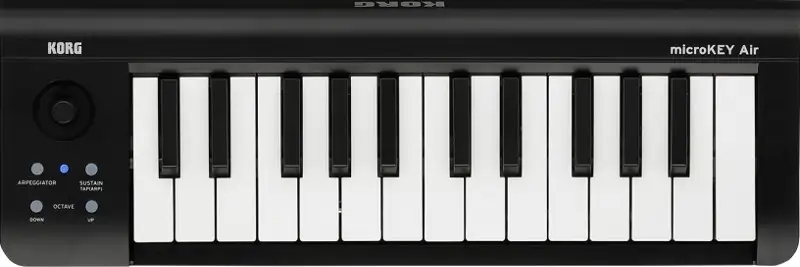
- 25 key velocity-sensitive mini keys
- Pitch/modulation joystick control
- Bluetooth enabled for wireless playing
- Dimensions: 15.55" x 5.16" x 2.05"
- Weight: 1.48lbs (without batteries)
The Korg microKEY is the best mini MIDI keyboard for minimalist musicians. This wireless keyboard allows you to connect to your laptop or iOS mobile devices without any cables!
And obviously, you still have the option of connecting via the USB port.
So aside from having no cable to trip over, what makes this mini keyboard so special?
The key action.
While it is a mini keyboard, the key action itself is fantastic. Whether you're playing piano parts, shredding a synth solo, or bashing out some drums, these keys will work for anything.
The microKEY 25 also has the obligatory octave shift buttons, plus an arpeggiator button, sustain/tap button, and a joystick for pitch and modulation control. There are no other control functions, but the shining feature of this board is the key action. Did I mention the key action?
Although this article is more about portability than anything else, it's worth mentioning the bundled software that comes with the microKEY: a copy of Reason Limited, a handful of plugins from AAS and UVI, the Korg Collection M1 Le synth sound module, and Izotope Ozone elements. Enough to get your creative juices flowing when you need some new sounds.
Why Buy
- Wireless connection to desktops, laptops, and iOS devices
- Premium keyboard action
- Nice software bundle included
3. Nektar Impact LX Mini
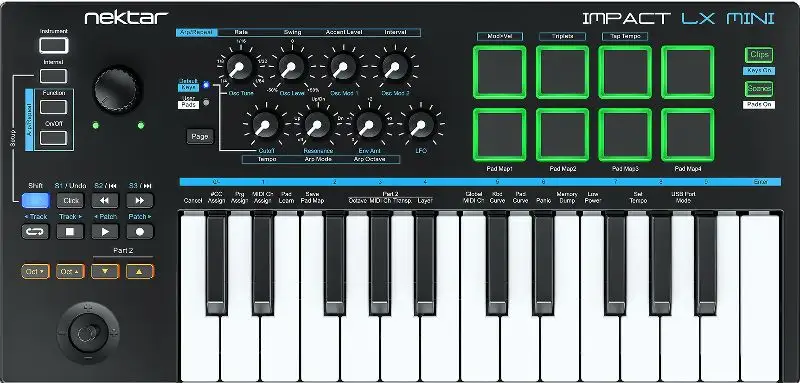
- 25 mini keys
- 8 pads, 8 rotary knobs
- 7 transport buttons for DAW control
- 2 built-in arpeggiators
- 1/4" footswitch input
- Dimensions: 15.35" x 7.28" x 1.49"
- Weight: 2.20lbs
Nektar have made a big impact (these puns are too easy) with their Panorama range of MIDI controllers. Now they've streamlined things, and made them more affordable, with the LX range of MIDI keyboards.
The 25 synth-action mini keys on this mini midi are velocity-sensitive, with four velocity curves available to suit different playing styles. But really, this portable keyboard is about the controllers.
The eight drum pads offer a fantastic response when playing (snare rolls are indeed a doddle). The pads can easily be assigned to different notes, or to send out MIDI CC messages, launch clips in Ableton Live, or navigate through scene markers. And all of this can be stored in one of four banks.
Eight rotary knobs come pre-mapped for controlling virtual instruments, or pan pots on your mixer, so you don't need to spend hours programming. Unless you want to - everything is completely assignable.
A large volume knob in the upper left corner controls the channel volume, and of course, this is also assignable.
Finally, a comprehensive set of DAW controls maps instantly to the music software of your choice (you'll need to download the integration software to do this).
To top all this off, the LX Mini is slim enough to fit easily into any backpack or messenger bag. Throw in your laptop, USB cable, and a pair of headphones and you'll be making music wherever you are.
Why Buy
- Excellent portable controller for music production
- Comprehensive DAW integration
- Light on the back, light on the pocket
4. Akai MPK Mini Mk3
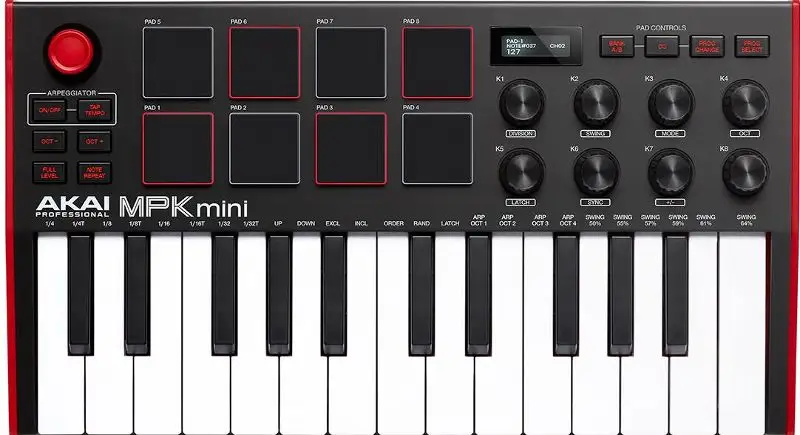
- 25 velocity-sensitive, synth-action keys
- 8 pads, 8 assignable knobs
- 4-way joystick for pitch bend & modulation control
- Dimensions: 12.5" x 7.13" x 1.75"
- Weight: 1.65lbs
No rundown of MIDI keyboard controllers would be complete without mentioning the Akai Professional MPK mini. Akai have a long and respected history when it comes to making portable keyboards, and the MPK mini delivers a powerful punch.
The synth-action keys on this controller are comparable to pretty much any other mini portable keyboard. The action may not be as good as the Korg microKEY, but they're responsive to your playing, and (in my opinion) feel pretty decent for the price.
The eight velocity-sensitive pads are based on classic MPC hardware and deliver a great feel for precision finger-drumming. The two banks of pads have note repeat and full level functions - essential for any serious beat-maker.
A new feature on the MPK mini MK3 version is the endless rotary knobs. In previous iterations of this controller, the dials had hard upper and lower points, which can lead to workflow issues when tweaking parameters.
Another new addition is the OLED display, so you can see parameter values as you change them. While this isn't a deal-breaker (after all, it's ultimately about how things sound), having some kind of visual cue for your parameter settings is a good thing to have on a MIDI controller.
Finally, it's worth noting the bundled software that comes with the MPK mini. MPC Beats is a DAW-based on the fabled MPC workflow, but the sounds it comes with are so good it's worth using as a plug-in on your native DAW. You also get 1,500 downloadable sounds, and a handful of virtual instruments from Air Music Technology, including the delightful Mini Grand.
Why Buy
- Industry-standard hardware
- Works plug 'n' play with any software
- Sturdy design and build
5. Novation Launchkey Mini Mk 3
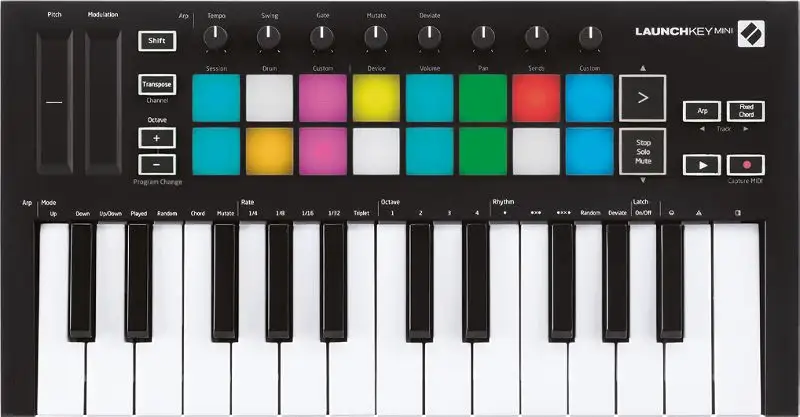
- 25 mini keyboard controller
- 16 velocity-sensitive pads, 8 rotary encoders
- Seamless integration with Ableton Live
- MIDI Out port
- Dimensions: 12.9" x 6.77" x 1.22"
- Weight: 1.55lbs
MIDI protocol is universal, so any MIDI controller will work with any DAW software. But the Novation Launchkey Mini Mk3 is specifically designed with the Ableton user in mind and lends itself well to that workflow.
Controls for Ableton include device macro-control, track select, record, MIDI capture, clip and scene launch, volume, pans, and sends. But if you're not digging how things are mapped out, all the controls are assignable so you can make the Launchkey work the way you want it to.
In addition to a sustain pedal input, there's also a TRS Type A 1/8 inch MIDI out port on the rear of the unit. This is not likely to appeal to the traveling musician, but if you're using the controller as part of a live rig, the MIDI out opens up the possibility of controlling external hardware synths from the Launchkey.
In addition to the multitude of controls, RGB pads, and 25 velocity-sensitive mini keys, the Launchkey Mini simplifies music production with its onboard arpeggiator, mutate and deviate functions, and Fixed Chord mode.
Fixed Chord Mode essentially maps any chord you choose across the keyboard, so everything makes harmonic sense. The mutate function takes your arpeggiated idea and reconstructs it into new statements, while the deviate function simply removes random notes from your arpeggiated riff to create new variations. All in all, some great creative tools going on here.
This compact controller from Novation also has full integration for Logic and Reason, functionality with any HUI-compatible DAW, and ships with a nice bundle of software instruments and effects. Including (you guessed it) Ableton Live Lite.
Why Buy
- Seamless integration with Ableton Live
- MIDI out for controlling hardware synths
- Great set of features for the price
6. M-Audio Oxygen Pro 25
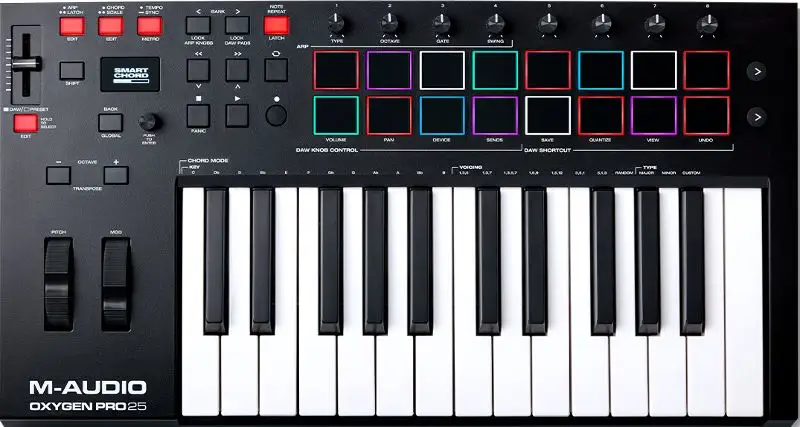
- 2 octave, semi-weighted keys, with aftertouch
- 16 backlit pads, 8 assignable knobs
- Controls auto-map to your DAW
- MIDI Out port
- Dimensions: 19.3" x 10.4" x 3.3"
- Weight: 5.4lbs
This offering from M-Audio is a little more chonky than the boards we've looked at up to now. But that's because this mini MIDI keyboard gives you semi-weighted keys feel, and a lot of controls, while still (just) being able to fit into your backpack.
It's also worth noting that the keys on this MIDI controller are full size, so those of you who get frustrated with the smaller keys found on other mini MIDI keyboards have nothing to worry about. The keys are also aftertouch-enabled, giving the player extra expressive power.
The Oxygen Pro has an impressive 16 velocity-sensitive drum pads, which double up as clip launchers, and function buttons to access other controls. Above the pads are 8 rotary knobs, which can be assigned to control any parameter on your virtual instruments.
To the left of the unit, the handful of DAW controls work with most major recording software. Just select your DAW from the onboard presets, and everything gets auto-mapped.
Additional features include a single (assignable) fader, onboard arpeggiator, Smart Chord, and Smart Scale technology (bypassing the need to reach for your music theory book when you want to push your musical envelope), a 1/4" sustain pedal input, and 5-pin MIDI output, for controlling external gear. There's also a bright OLED screen to make editing uncomplicated.
For the price, the feel of this board is pretty sturdy. At just over 5 lbs, it does create more of a burden for your back when lugging it around, but the payoff is in the feel of the keys, and the amount of control you get over your music production process.
Why Buy
- Lots of pads, with multiple functions
- Onboard instant mapping of controls to your DAW - great for multi-DAW users
- Make music right out of the box with the comprehensive software bundle
7. Arturia Minilab MK II
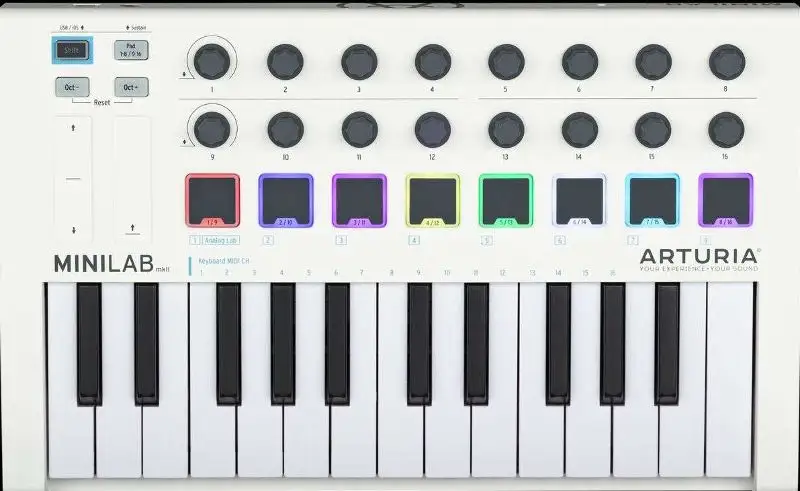
- 2 octave slim key keybed
- 8 pads, 16 knobs
- Pitch and modulation strips
- Save MIDI control maps on 8 internal presets
- Dimensions: 14" x 8.7" x 2"
- Weight: 3.3lbs
Arturia have some fantastic MIDI controllers on offer, and the Minilab is a portable and inexpensive version of these.
The synth-action keys on the Minilab are slightly smaller than full size, but big enough that you won't be playing P-blunt when you meant to play D-sharp. You can enhance your performance using the pitch and modulation strips. Helpfully, the pitch strip returns to zero when it's released. The modulation strip stays where it's at, which makes sense but without the visual cue as to its setting could get a little confusing.
The eight pads are velocity-sensitive and come with two banks. They are a little smaller than pads on other mini keyboards - presumably to make room for the sixteen encoders. These knobs can all be assigned to plug-ins or DAW parameters, and two of them are clickable essentially making them double up as buttons.
Previous owners of the Minilab have complained about erratic behavior from the control knobs. Arturia have addressed this with a firmware update, so if you do go for this MIDI controller be sure to download the firmware update right away!
The other big selling point for the Minilab is the included software. With access to 500- presets from Analog Lab Lite you can go nuts peppering your tunes with classic vintage synth sounds. You also get a copy of Ableton Live Lite so you can start creating analog-sounding tunes right away. There is, naturally, an upgrade path to the full versions of both.
Why Buy
- Sturdy build and quality feel
- Controls iOS virtual instrument apps
- Tons of vintage synth sounds in the box
8. Novation FL Key 37
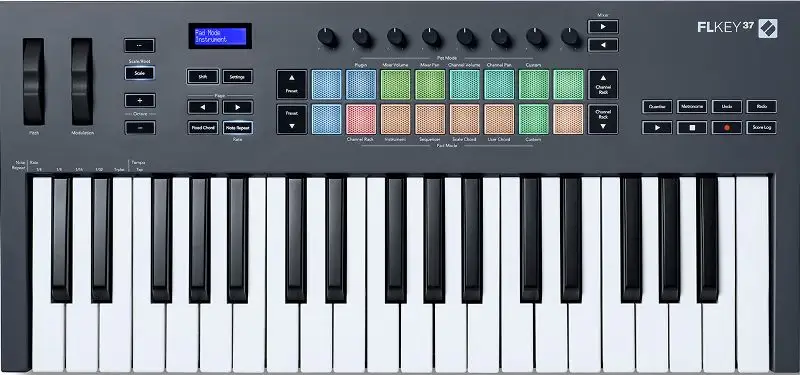
- 37 full-size, velocity-sensitive keys
- 16 pads, 8 assignable knobs
- Complete integration with FL Studio
- Dimensions: 21.85" x 10.16" x 3.03
- Weight: 4.9lbs
Fans of FL Studio were delighted earlier this year when Novation announced the release of the FL Key - the first-ever dedicated MIDI keyboard controller for the DAW that's been around 24 years.
The FL Key comes in two sizes; the 25-key Mini model, and this one - the 37, with its full-size keys. Every part of this MIDI keyboard has been designed to integrate with its namesake DAW - the transport controls, the drum pads, rotary knobs, and dedicated channel rack and preset buttons.
If you're using FL native plug-ins, you'll find the controllers auto-map to parameters on the software (although sometimes the mapping can be a bit confusing). The drum pads can be used to program beats, control the FL step sequencer and instruments, and play directly into the channel rack.
The FL Key comes with a 6-month trial of FL Studio Producer Edition, plus an instrument and effects software bundle. If you're a long-time user of the software and have developed your own unique workflow, you may find yourself taking a few steps back to integrate this controller into your process. But I always say all change is good, and this could trigger new creative directions for you.
And if you're a fan of the software looking to develop a streamlined workflow, the FL Key is absolutely one of the best MIDI controllers you can get.
Why Buy
- Streamline your workflow in FL Studio
- Connect external gear with the 5-pin MIDI out connection
- Custom programming of all pad and knob functions
9. NI Komplete Kontrol M32
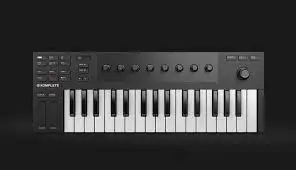
- 32 micro-size synth-action keys
- 8 touch-sensitive control knobs
- Dedicated transport controls (DAW specific)
- Dimensions: 18.7" x 6.57" x 1.96"
- Weight: 2.27lbs
Native Instruments are well-known for their gargantuan Komplete collections of instrument and effects software. The Komplete Kontrol set of MIDI keyboards is designed to integrate smoothly with this software, allowing the user to browse presets and tweak sounds directly from the board.
All the controls come pre-mapped to Komplete and NKS software, and with the OLED display, parameter editing is a doddle.
The DAW controls work with Logic, Ableton, Cubase, Garageband, and Nuendo - not the most comprehensive integration ever, but if you already use any of these bits of kit you're in luck.
The keybed is very nice to play, even if the keys are a little on the small side. Pitch and mod control is handled by the touch strips to the left of the keys.
And while there aren't any pads on the M32, it does play very well with Maschine hardware. If you're a big NI fan, you could build a tasty mobile rig for traveling using the M32 and the Maschine Mikro.
Why Buy
- Cost-effective gateway into the sonic world of Native Instruments
- Pre-mapped to Native Instruments instruments and effects
- The Smart Play feature can take your music to new places
10. IK Multi iRig Keys I/O 25
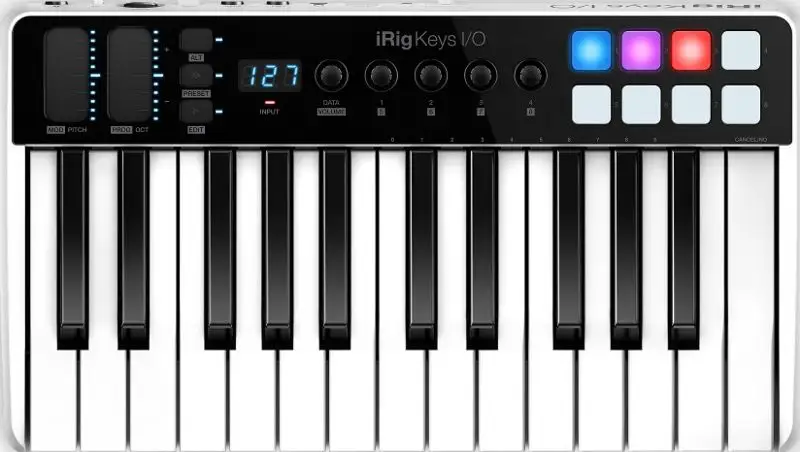
- 25 full-size, synth-action keys
- 8 pads, 5 knobs
- Audio interface - 2 in/2 out, plus a headphone jack
- Dimensions: 14.7" x 8.2" x 2.6"
- Weight: 2.8lbs
Our last controller in this list is a bit of a wildcard. It's unique in the world of MIDI controllers in that it features a built-in USB audio interface, recording at an impressive 24 bit/96kHz.
This makes the iRig the best portable MIDI keyboard for musicians who also need to capture live instruments while on the road.
The pads and knobs are assignable, and there are some rudimentary DAW controls available too. The two strips control pitch and modulation by default, but can also be assigned to other parameters.
The audio interface features a Neutrik mic/line combo input with phantom power, and a 1/4" jack input for recording instruments directly. Two 1/4" L/R outs and a 1/8" headphone jack give the user plenty of options for on-the-road monitoring.
The iRig is USB powered, with the option of using 4 AA batteries, or an external power supply. This would be a wise choice if you're recording onto your iOS device or using phantom power on the combo input.
If you're looking for a way to record and control your production on the road, the iRig is for you. If recording live sources is not on the cards for you, there are better options for your money.
Why Buy
- Midi controller & audio interface in one
- iOS compatible
- Perfect for the wandering musician who needs to capture live recordings
Conclusion
There you have it! A full run down of some of the best mini MIDI keyboards money can buy. Now, the decision is yours. Have fun making music as a nomad, and don't forget you can give your masterpieces the final polishing touches right here on eMastered !


